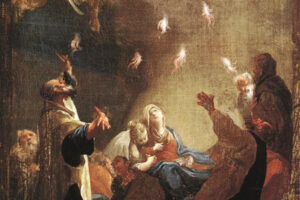Note from 2024: This post from six years ago had several broken links due to the move to the new server, so I removed them and slightly edited the gaps that remained.
______ 卐 ______
The present is a reply to what Joseph Walsh said in a previous thread, ‘70 AD’.
The young Hitler once wanted to enter a Benedictine monastery. Undoubtedly there were reminiscences and a Judeo-Christian tail in Hitler, Himmler and others of our heroes. Even in myself! Not long ago I said on this site that I considered myself ‘panentheist’, keeping in mind the philosophers of German idealism who flourished in the century when the Führer was born.
Not everything that Hitler opined should be accepted automatically, for example, what about Charlemagne he said in a table talk. Pierce, Kemp and Sunic had not yet spoken about this Christian murderer of non-Christian Saxons.
I speak of monotheism in the West, not of monotheism in universal history (Egypt, Palestine and the desert religions). In the Western forest and its Aryan man, the idea of a single god is clearly a Judeo-Christian bug that has its roots in the ‘Apocalypse for Whites’, as I named the Evropa Soberana series (PDF here, the Rome-Judea conflict). The fact that you believe that theism is more probable than polytheism means that—as I myself was in the past, even on this site!—there are Judeo-Christian reminiscences in your mind.
It is very difficult to remove them because we grew up with them. In no way polytheism is more improbable than theism. We suffer that impression only because we were born in a Christian milieu, and we have burnt the idea of a single personal god in the depths of our psyche. Just imagine a world without Christianity. If the Greco-Roman world had not been assassinated by Judeo-Christians today there would be a lot of atheism, but the agnostics would still feel that the existence of the picaresque Gods of the classical pantheon was infinitely more probable and benign than the existence of the surly god of the Jews.
The fact that we fail to realise this in the Christian era (I write this in 2018 AD) can only mean that we have not run several programs in our minds to disinfect ourselves from Judeo-Christian programming. A good program is what Nietzsche says on the last page of The Antichrist: ‘The holy history should be called by the name it deserves, the cursed history; the words “God”, “saviour”, “redeemer”, “saint” should be used as terms of abuse, to signify criminals’.
But Nietzsche did not know computers. Here is a modern metaphor. The mind of the common Westerner is similar to the hard drive that an internet teacher in Houston told us, in class, that was so infected that it was better to throw it away.
Confronted with that hard disk, the types of the Alt Lite instead of throwing it have run antivirus programs like Norton and Kaspersky. The Alt Right types, in addition to those two programs have run on the hard drives of their minds, Cylance and PCprotect. The white nationalists, in addition to these four programs, have run AVG and McAfee. The national socialists of our time, in addition to those six, have run in their minds Panda. But only in recent times yours truly runs in his mind, in addition to those seven, another antivirus, TotalAV: which expands the Jewish problem into the Christian problem (let’s imagine it in a Venn diagram).
 The gradual Semitic infection of the Aryan mind has been going on for two thousand years. As commentator Devan said recently on this site, today whites are, psychically speaking, Jews. It is impossible to diagnose the whole infection unless one becomes an aseptic priest of fourteen words. Part of the priest’s job is to detect the Semitic malware in his own mind, and run each of the antiviruses to eliminate it.
The gradual Semitic infection of the Aryan mind has been going on for two thousand years. As commentator Devan said recently on this site, today whites are, psychically speaking, Jews. It is impossible to diagnose the whole infection unless one becomes an aseptic priest of fourteen words. Part of the priest’s job is to detect the Semitic malware in his own mind, and run each of the antiviruses to eliminate it.
Of course, when the priest goes out and sees the white normies, all he can think about is throwing the hard drive of these NPCs in the trashcan, as my old internet teacher advised us. Running eight antivirus programs in your own mind is a feat for a chosen few!






